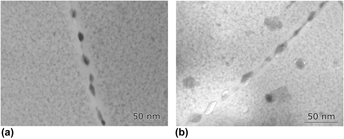Crossref Citations
This article has been cited by the following publications. This list is generated based on data provided by
Crossref.
Soyama, Juliano
Zepon, Guilherme
Lopes, Thiago Pama
Beraldo, Leamar
Kiminami, Claudio Shyinti
Botta, Walter José
and
Bolfarini, Claudemiro
2016.
Microstructure formation and abrasive wear resistance of a boron-modified superduplex stainless steel produced by spray forming.
Journal of Materials Research,
Vol. 31,
Issue. 19,
p.
2987.
Lin, Y.C.
Zhang, Jin-Long
Chen, Ming-Song
Zhou, Ying
and
Ma, Xiang
2016.
Electrochemical corrosion behaviors of a stress-aged Al–Zn–Mg–Cu alloy.
Journal of Materials Research,
Vol. 31,
Issue. 16,
p.
2493.
Luiggi, Ney J.
and
Valera, María del V.
2017.
Kinetic study of an AA7075 alloy under RRA heat treatment.
Journal of Thermal Analysis and Calorimetry,
Vol. 130,
Issue. 3,
p.
1885.
Xie, Liuqun
Lei, Qian
Wang, Mingpu
Sheng, Xiaofei
and
Li, Zhou
2017.
Effects of aging mechanisms on the exfoliation corrosion behavior of a spray deposited Al–Zn–Mg–Cu–Zr aluminum alloy.
Journal of Materials Research,
Vol. 32,
Issue. 6,
p.
1105.
Su, Ruiming
Su, Jianhao
Qu, Yingdong
You, Junhua
and
Li, Rongde
2017.
Retrogression on corrosion behavior of spray formed Al-7075.
Journal of Materials Research,
Vol. 32,
Issue. 13,
p.
2621.
Kumar, Neeraj
Manoj, Manoranjan Kumar
and
Phani, M. Kalyan
2018.
Influence of Potential Scan Rate on Corrosion Behaviour of Heat Treated AA 7075 Alloy in Sulphuric Acid Solution.
Material Science Research India,
Vol. 15,
Issue. 1,
p.
91.
Li, Rongde
Liu, Tong
Su, Ruiming
and
Qu, Yingdong
2018.
Microstructure and Mechanical Properties of Spray-Formed 7075 Alloy During Retrogression.
Journal of Materials Engineering and Performance,
Vol. 27,
Issue. 9,
p.
4437.
Ditta, Allah
Wei, Lijun
Xu, Yanjin
and
Wu, Sujun
2019.
Effect of hot extrusion and optimal solution treatment on microstructure and properties of spray-formed Al-11.3Zn-2.65Mg-1Cu alloy.
Journal of Alloys and Compounds,
Vol. 797,
Issue. ,
p.
558.
Azarniya, Abolfazl
Taheri, Ali Karimi
and
Taheri, Kourosh Karimi
2019.
Recent advances in ageing of 7xxx series aluminum alloys: A physical metallurgy perspective.
Journal of Alloys and Compounds,
Vol. 781,
Issue. ,
p.
945.
Ditta, Allah
Lijun, Wei
Long, Li
Yanjin, Xu
Naseem, Kashif
and
Sujun, Wu
2019.
Microstructure and Mechanical Properties of Spray-formed High Zn-containing Al-Zn-Mg-Cu alloy.
p.
74.
Lin, Gaoyong
Song, Weiyuan
Feng, Di
Li, Kun
Feng, Yongping
and
Liu, Jinxia
2019.
Study of microstructure and mechanical property heterogeneity throughout the wall thickness of high strength aluminum alloy thick-wall pipe.
Journal of Materials Research,
Vol. 34,
Issue. 15,
p.
2736.
Su, Ruiming
Liu, Tong
Qu, Yingdong
Bai, Guang
and
Li, Rongde
2019.
Mechanical Properties and Corrosion Behavior of Spray-Formed 7075 Alloy with One-Stage Aging.
Journal of Materials Engineering and Performance,
Vol. 28,
Issue. 4,
p.
2212.
Wang, Kaining
Su, Ruiming
Liu, Tong
Qu, Yingdong
and
Li, Rongde
2020.
Electrochemical assessment of laser heat treatment of an Al–Zn–Mg–Cu alloy.
Materials and Corrosion,
Vol. 71,
Issue. 3,
p.
374.
Ditta, Allah
Wei, Lijun
Xu, Yanjin
and
Wu, Sujun
2020.
Microstructural characteristics and properties of spray formed Zn-rich Al-Zn-Mg-Cu alloy under various aging conditions.
Materials Characterization,
Vol. 161,
Issue. ,
p.
110133.
Wang, Yu
Zhu, Langjie
Niu, Guodong
and
Mao, Jian
2021.
Conductive Al Alloys: The Contradiction between Strength and Electrical Conductivity.
Advanced Engineering Materials,
Vol. 23,
Issue. 5,
Wang, H.
Zhang, Z.J.
Cong, F.G.
Ren, W.C.
Gong, B.S.
Liu, R.
Li, R.H.
Zhou, X.H.
Purcek, G.
Demirtas, M.
Bathaee, F.
Abedi, H.R.
and
Zhang, Z.F.
2023.
Research on anisotropy of the 7B50 super thick plate.
Journal of Alloys and Compounds,
Vol. 960,
Issue. ,
p.
171004.
Guo, Fuqiang
Duan, Shuwei
Pan, Yuzhe
Wu, Dongting
Matsuda, Kenji
Wang, Tao
and
Zou, Yong
2023.
In-situ electrochemical analytical effect of aging treatment on stress corrosion behavior of Al–Zn–Mg–Cu aluminum alloy.
Journal of Materials Research and Technology,
Vol. 23,
Issue. ,
p.
5807.
Wang, Yuezhu
Su, Ruiming
Jin, Meiling
and
Li, Guanglong
2024.
Effect of Non-isothermal Cooling Aging on the Microstructure and Properties of Al-Zn-Mg-Cu Alloys.
JOM,
Vol. 76,
Issue. 4,
p.
1951.
Wang, Yuezhu
Su, Ruiming
Jin, Meiling
and
Li, Guanglong
2024.
Effect of non-isothermal aging on mechanical properties, corrosion behavior and microstructure of 7075 aluminum alloy.
Materials Today Communications,
Vol. 39,
Issue. ,
p.
108794.
Fan, Caihe
Li, Yihui
Wu, Qin
Yang, Jianjun
Hu, Zeyi
Ni, Yumeng
and
Ding, Liuxin
2024.
Effect of cold rolling deformation on the microstructure and mechanical properties of spray-formed Al–Zn–Mg–Cu alloy.
Journal of Materials Research,
Vol. 39,
Issue. 3,
p.
471.





